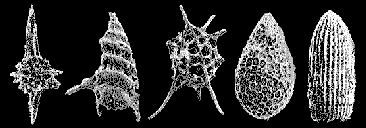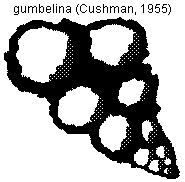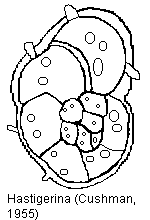Marine Protozoa
Lecture notes
Protozoans
Sub kingdom: protozoa of Kingdom Protista 31,250 species in 7
phyla Features: unicellular, freeliving or parasitic, mostly
solitary though some colonial (ciliate and flagellates) move by
pseudopodia, flagella, or cilia, some amoeba with tests,or
shells, ciliates possess a mouth (cystostome) and nuclei of two
sizes, reproduction mainly asexual, sexual reproduction in some
groups.
Special marine ones... Subphylum Sarcodina
(including amoeba) produce so-called pseudopodia-flowing
extensions of the cell which can extend one or more at a time
(depending what species) . Amoeboid marine protozoans, the
Foraminiferans and Radiolarians build cases around themselves.
Forams secrete a calcium (chalky) carbonate shell or test, which
resembles a microscopic snail shell. Their pseudopod extend
through pores to form a network used to trap diatoms and other
minute organisms suspended in water. Most live on the bottom
either free or attached. The covering of forams is potmarked with
numerous holes which the pseudopods extend through to capture
smaller ciliates and detritus. As these die, they sink to the
ocean floor to form ooze which makes up thousands of square miles
of the ocean floor. (white cliffs of Dover are foram tests).
Scientists use the fossil tests to measure variations in the
worlds temperatures as the structure and sizes of the tests
change with water temp. changes. Forams living in cold water have
fewer pores than those in warm water.
Subphylum Sarcodina
(including amoeba) produce so-called pseudopodia-flowing
extensions of the cell which can extend one or more at a time
(depending what species) . Amoeboid marine protozoans, the
Foraminiferans and Radiolarians build cases around themselves.
Forams secrete a calcium (chalky) carbonate shell or test, which
resembles a microscopic snail shell. Their pseudopod extend
through pores to form a network used to trap diatoms and other
minute organisms suspended in water. Most live on the bottom
either free or attached. The covering of forams is potmarked with
numerous holes which the pseudopods extend through to capture
smaller ciliates and detritus. As these die, they sink to the
ocean floor to form ooze which makes up thousands of square miles
of the ocean floor. (white cliffs of Dover are foram tests).
Scientists use the fossil tests to measure variations in the
worlds temperatures as the structure and sizes of the tests
change with water temp. changes. Forams living in cold water have
fewer pores than those in warm water.
FORAMS ETC. There may be over 20,000 species
of the order Forminiferia, which are characterized by  having a rhizopodia and a one chambered
or multi- chambered test that may be calcareous or siliceous with
various substances such as sand or sponge spicules cemented
together by
having a rhizopodia and a one chambered
or multi- chambered test that may be calcareous or siliceous with
various substances such as sand or sponge spicules cemented
together by pseudochitinous or gelatinous
materials. They are among the largest protozoans with some
reaching 100mm but usually .5 to 1.0 mm The tests are various
shapes--oval, tubular, branched, spiral, etc. Most shells are
multi chambered consisting of a series of successively larger
chambers which are separated internally with pores or canals
connecting them. The cytoplasm is found in all the chambers and
is continuous through pores connecting the chambers. By passing
though the pores of the test, the cytoplasm forms a layer
(ectoplasm) over the test which connects to the endoplasm through
the pores. As the animal grows it adds successive chambers to the
initial chamber.
pseudochitinous or gelatinous
materials. They are among the largest protozoans with some
reaching 100mm but usually .5 to 1.0 mm The tests are various
shapes--oval, tubular, branched, spiral, etc. Most shells are
multi chambered consisting of a series of successively larger
chambers which are separated internally with pores or canals
connecting them. The cytoplasm is found in all the chambers and
is continuous through pores connecting the chambers. By passing
though the pores of the test, the cytoplasm forms a layer
(ectoplasm) over the test which connects to the endoplasm through
the pores. As the animal grows it adds successive chambers to the
initial chamber.
They capture their prey by means of their pseudopodal network
which exhibits active streaming movements. They are found in
marine and brackish water and only a few in fresh. A few are
pelagic or sessile but most are creeping bottom dwellers
(benthonic). A third of the ocean bottom is covered with
Globigerina ooze, made mainly of the accumulation of the tests of
this common foram. (usually in water under 4000 m deep because
tests dissolve in the high concentration of CO2 in deep water.)
Good fossils and important in detecting oil bearing strata.
(From Bio of Inverts Hickman Mosby Co ST Louis 1973)
Radiolaria (Subclass) Radiolarians form a
glass like test composed of silica which is studded with long
transparent spines to increase buoyancy and ward off predators.
Typical shells are spheric with radiating spines though the
structure varies...thin needlelike pseudopod capture food.
The radiolarians also form ooze, though radiolarian ooze and
is usually found deeper being able to resist more pressure than
the calcium carbonate foram tests.Radiolarian
Web page
Ciliates are some of the protozoans that use cilia for
locomotion. ..creeping over the bottom, living in gills, attached
etc. The Tintinnids build their own quarters that drift in the
water.
Reproduction is usually asexual binary fission whereby each
effort results in two identical daughter cell (MITOSIS). This
occurs when conditions are favorable...warm, lots of food etc.,.
but sexual reproduction can occur in some when adverse conditions
(drying up) occur as a survival method. The forams have
alternation between sexual and asexual generations, having
asexual reproduction to produce many organisms which secrete
shells around themselves and when mature, they produce identical
gametes which are liberated into the sea and fuse in pairs to
produce individuals which in turn secrete a shell grow to
maturity and repeat the cycle.
Life cycles are known for a few foraminiferans. They have two
phases, one asexual and the other sexual. They are also
dimorphic, having two types of individuals in each species, based
mainly upon the size of the initial chamber (proloculm) of the
test. The megalospheric type (gamont) has a large chamber
(proloculum), one nucleus and is small in size while the
microspheric type (schizont) has a small chamber, many nuclei and
is relatively large. This is due to reproductive cycles which
alternate between sexual and asexual generations.
Ecology Its complex as it would be for
organisms found in every environment . They occur commonly in
plankton...benthic communities, marine depths (13,000 ft for a
foram) and since many protozoans exploit bacteria as a food
source, they form part of the decomposer food web in nature. It
is thought that they stimulate the rate of decomposition by
bacteria by grazing on bacteria and keeping the bacteria
community in a state of physiological youth and hence at the
optimum level of efficiency. Ciliates can cause illness sees in
some organisms.
Chapter Questions
Return to Selections
Back to Home Page
<
 Subphylum Sarcodina
(including amoeba) produce so-called pseudopodia-flowing
extensions of the cell which can extend one or more at a time
(depending what species) . Amoeboid marine protozoans, the
Foraminiferans and Radiolarians build cases around themselves.
Forams secrete a calcium (chalky) carbonate shell or test, which
resembles a microscopic snail shell. Their pseudopod extend
through pores to form a network used to trap diatoms and other
minute organisms suspended in water. Most live on the bottom
either free or attached. The covering of forams is potmarked with
numerous holes which the pseudopods extend through to capture
smaller ciliates and detritus. As these die, they sink to the
ocean floor to form ooze which makes up thousands of square miles
of the ocean floor. (white cliffs of Dover are foram tests).
Scientists use the fossil tests to measure variations in the
worlds temperatures as the structure and sizes of the tests
change with water temp. changes. Forams living in cold water have
fewer pores than those in warm water.
Subphylum Sarcodina
(including amoeba) produce so-called pseudopodia-flowing
extensions of the cell which can extend one or more at a time
(depending what species) . Amoeboid marine protozoans, the
Foraminiferans and Radiolarians build cases around themselves.
Forams secrete a calcium (chalky) carbonate shell or test, which
resembles a microscopic snail shell. Their pseudopod extend
through pores to form a network used to trap diatoms and other
minute organisms suspended in water. Most live on the bottom
either free or attached. The covering of forams is potmarked with
numerous holes which the pseudopods extend through to capture
smaller ciliates and detritus. As these die, they sink to the
ocean floor to form ooze which makes up thousands of square miles
of the ocean floor. (white cliffs of Dover are foram tests).
Scientists use the fossil tests to measure variations in the
worlds temperatures as the structure and sizes of the tests
change with water temp. changes. Forams living in cold water have
fewer pores than those in warm water. having a rhizopodia and a one chambered
or multi- chambered test that may be calcareous or siliceous with
various substances such as sand or sponge spicules cemented
together by
having a rhizopodia and a one chambered
or multi- chambered test that may be calcareous or siliceous with
various substances such as sand or sponge spicules cemented
together by pseudochitinous or gelatinous
materials. They are among the largest protozoans with some
reaching 100mm but usually .5 to 1.0 mm The tests are various
shapes--oval, tubular, branched, spiral, etc. Most shells are
multi chambered consisting of a series of successively larger
chambers which are separated internally with pores or canals
connecting them. The cytoplasm is found in all the chambers and
is continuous through pores connecting the chambers. By passing
though the pores of the test, the cytoplasm forms a layer
(ectoplasm) over the test which connects to the endoplasm through
the pores. As the animal grows it adds successive chambers to the
initial chamber.
pseudochitinous or gelatinous
materials. They are among the largest protozoans with some
reaching 100mm but usually .5 to 1.0 mm The tests are various
shapes--oval, tubular, branched, spiral, etc. Most shells are
multi chambered consisting of a series of successively larger
chambers which are separated internally with pores or canals
connecting them. The cytoplasm is found in all the chambers and
is continuous through pores connecting the chambers. By passing
though the pores of the test, the cytoplasm forms a layer
(ectoplasm) over the test which connects to the endoplasm through
the pores. As the animal grows it adds successive chambers to the
initial chamber.